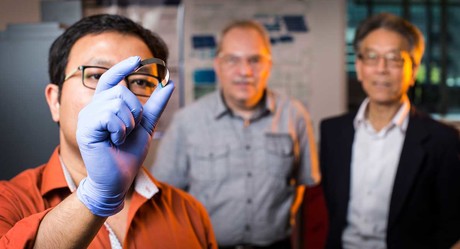Wearable copper ribbons for harvesting and storing energy

Scientists from the University of Wollongong (UOW) have developed a flexible copper strip that could be the answer to powering electronic devices via the clothes we wear.
Collaborating with the University of Central Florida’s (UCF) NanoScience Technology Center, the researchers integrated a perovskite-based solar cell and a supercapacitor in a thin copper ribbon. This enabled the ribbon to simultaneously harvest and store energy — unlike other wearable power sources which typically require one device to harvest the energy and another to store it.
“Presently, most portable electronic and wearable devices carry rechargeable batteries, even when they are used in places where solar energy is plentiful,” said UOW Senior Lecturer Dr Konstantin Konstantinov.
“We’ve reduced this need by integrating a solar cell and a supercapacitor in one device.
“The electrons generated by the solar cell are directly transferred and stored on the reverse side of its electrode, which in turn also functions as an electrode for the supercapacitor.”
Writing in the journal Nature Communications, the researchers revealed, “When the flexible solar ribbon is illuminated with simulated solar light, the supercapacitor holds an energy density of 1.15 mWh cm−3 and a power density of 243 mW cm−3.” Furthermore, they successfully used a tabletop loom to weave the ribbons into a square of yarn to demonstrate their potential in wearable electronics.

UCF nanotechnology researcher Associate Professor Jayan Thomas said one major application for the method could be in the military, with the ribbons incorporated into the jackets of soldiers who spend all day walking in the sun.
“Some of them are carrying more than 30 pounds of batteries on their bodies,” said Professor Thomas. “It is hard for the military to deliver batteries to these soldiers in this hostile environment.”
Dr Konstantinov added that the ribbon could also serve as a self-sufficient energy system for electric vehicles, noting, “Cars parked directly under the sun have an opportunity to utilise the abundant energy from sunlight. The flexible ribbon could be incorporated into the body of the car to make that possible.”
According to UOW PhD student Md Monirul Islam, the next step is to use a lithium-ion battery instead of a supercapacitor to store the energy.
“Since the energy density of lithium-ion batteries is higher than that of supercapacitors, fabricating thin-film lithium-ion batteries instead of supercapacitors on the reverse side of the solar cell ribbon would considerably improve its energy density and possible applications,” he said.
Predictive AI model enhances solid-state battery design
ECU researchers are working on ways to make solid-state batteries more reliable with the help of...
Boosting performance of aqueous zinc–iodine batteries
Engineers from the University of Adelaide have enhanced aqueous zinc–iodine batteries using...
Sodium-ion battery breakthrough boosts energy storage
Scientists have discovered that leaving water inside a key material, rather than removing it,...




